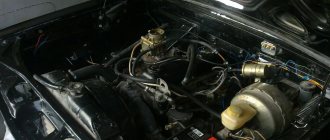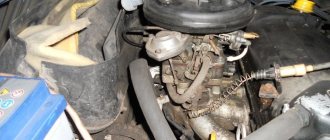One way to assess the proper functioning of the power plant is to check the condition of the spark plugs. Any disruption of the processes taking place in the cylinders will immediately leave marks on these elements. In most cases, spark plugs provide insight into the operation of the ignition and power systems. But there are also symptoms indicating problems with other components of the power plant.
One such sign is the detection of oil traces on the spark plugs. Lubricant on the spark plugs can appear due to a number of specific malfunctions. Some of them do not pose any particular danger to the engine, but others are a signal of serious problems that can lead to expensive repairs.
Causes of oil on spark plugs
If the candles are covered with oil, then first of all it is necessary to determine exactly which part has the most of it. Many car owners are faced with a situation where only the threads and body are coated with lubricant, while the electrodes are dry and have a normal color (light brown). But it also happens that the entire base ends up in oil.
At the same time, in addition to traces of lubricant on the spark plugs, a malfunction with the engine manifests itself in other ways - deterioration in dynamics, increased exhaust smoke, oil burns. In order for it not to be the cause, it must be eliminated.
Most often, the appearance of grease marks occurs due to wear and damage:
- Valve guides.
- Oil seals.
- Valves.
- Cylinder head gaskets (cylinder head).
- CPG elements (cylinder-piston group).
Traces of lubricant on the body and threads are mentioned for good reason, since oil can get onto the spark plug not only from the cylinder, but also due to external leaks. So, on some cars, a loose fit of the cylinder head cover gasket is considered a “disease”. As a result, candles seep through leaks and get into the wells. Thus, oil accumulates in the wells of the spark plugs and when unscrewing the spark plugs, both the body and the threads are simply smeared in the accumulated lubricant. The problem is “treated” by replacing the gasket and coating it with sealant.
Why is there oil in the spark plug wells and how to fix the breakdown
It is well known that the engine and its systems have various seals and gaskets in their design, which provide the necessary seal at the junction of individual parts and elements. This seal allows the joints to be sealed, which prevents the leakage of engine oil and other technical fluids.
At the same time, during the operation of the car, the owner may quite often encounter the fact that the oil still begins to leak. In some cases, the lubricant actively pollutes the engine from the outside, oil gets into the spark plug wells, flows out from under the oil filter, camshaft or crankshaft seals leak, etc.
It is important to understand that oil leaks not only lead to increased consumption of lubricant and pollute the internal combustion engine, but also cause various malfunctions, that is, they affect the operation of the engine. One of these common problems is considered to be the problem when oil is found in the spark plug wells. Next we will talk about the reason for oil getting into the spark plug wells, as well as how to fix such a leak with your own hands.
Consequences of a malfunction
If you ignore the problem of lubricant getting into the cylinders, which is indicated by traces of oil on the spark plug, the consequences will be very serious. The lubricant is not able to completely burn out in the cylinders, moreover, the part of it that does burn out becomes the cause of a large amount of soot.
This carbon deposits on the internal surfaces of the cylinder, which affects the processes taking place inside it, and also leads to the occurrence of rings. Because of this, the amount of oil entering the combustion chamber increases sharply. As a result, the engine power drops significantly, and it begins to intensively consume lubricant and fuel. Restoring the engine after this is quite difficult and financially expensive, since a major overhaul is required.
Useful tips
As you can see, replacing the sealant under the valve cover is not a complicated procedure. The main requirements include thorough cleaning of the old layer and proper application of fresh sealant to the surface.
The applied layer must be even and no interruption is allowed. It should also be noted that the sealing compound must also be used to treat the joints between the connections of the spark plug wells, having previously removed the old sealant from there.
If only one engine needs to be repaired, then it will be enough to purchase a small tube of heat-resistant sealant. You can also read about selecting the best sealant for the engine in our separate article.
It should be noted that the use of sealant if the valve cover on a particular internal combustion engine is installed through a rubber gasket is undesirable. In this case, it is necessary to purchase a new high-quality gasket, after which the mating surfaces are checked. Next, the new valve cover gasket is installed in place, after which the valve cover is tightened, taking into account the order and torque of the fasteners.
What can be done
If the spark plugs are filled with oil, then identifying the cause is not so difficult, but eliminating it can be a troublesome task.
If we talk about the case of a leaking valve cover gasket described above, then everything is very simple - oil is noticed in the spark plug wells - the sealing element requires replacement.
It’s worse if grease is found on the bottom of the spark plug (and it can be on one, several or all spark plugs).
A compression test will partially help here. If the rings are stuck or the valves do not fit tightly, it will certainly decrease. If there are traces of lubricant on the spark plugs, but the compression is fine or even increased (which happens due to the oil present in the combustion chamber, which acts as a seal in the existing gaps), you will have to disassemble the cylinder head to assess the condition of the oil seals and valve guides. In general, it is the last two elements that are the most common reasons for lubricant getting into the cylinders, including spark plugs.
Do not forget that the engine itself has a certain resource. If it is noticed that all the spark plugs are in oil, and the compression has dropped significantly below normal, it may be worth considering a major overhaul, since the degree of engine wear has reached critical levels.
Summary
The reasons for oil leakage into the spark plug wells of the sixteen-valve Lada Granta power plant is a loose connection of the valve cover to the camshaft bed and/or the camshaft cover to the cylinder head. A malfunction increases the level of fire danger and leads to failure of the ignition coil and spark plug.
Treating the joints of the mating parts of the cylinder head with an anaerobic sealant helps prevent leakage. To apply the sealing compound, it is necessary to dismantle the parts and prepare the surfaces. When reassembling, be sure to replace the receiver gaskets and use a torque wrench.
Source
What color is considered normal?
The performance of the gasoline power unit is indicated by spark plug electrodes painted in a light brown tint, without oil deposits and soot. A similar picture is observed in completely new engines and engines that have undergone a major overhaul.
If the color of the working part differs from the specified one, it is advisable to carry out further diagnostics and identify the cause of the problem. Moreover, the engine itself is not always the culprit. What color options are there for spark electrodes:
- light gray or white;
- black;
- brick or frankly red tint.
In addition to all sorts of colors, the candle skirt is covered with various deposits - soot, brown soot, or may simply look wet. These phenomena are also considered signs of various malfunctions. It is proposed to consider each situation in more detail.
Cleaning the ignition elements
Spark plugs do not always require immediate replacement; sometimes they can simply be cleaned and the possible cause of deposits can be eliminated. This procedure can be carried out in two ways:
- Mechanical cleaning method. It consists of using simple sandpaper or a small wire brush. Despite the simplicity of the method, it has a number of disadvantages. With such cleaning, the coating on the SZ electrodes can be damaged, and simple scratches can cause increased accumulation of deposits.
- Chemical method. It is more preferable, especially for removing black deposits. The car enthusiast will need to prepare simple cleaning products, a toothbrush and a rag. The elements need to be soaked for about half an hour and then rinsed well. After drying, the candles can be used again.
What else you need to know
Most car owners make one big mistake when making repairs - they forget about the spark plugs. As we remember, a candle in a flooded well will have two states:
- in oil - in soot and in oil
As you might imagine, excess buildup on a candle will have a negative impact on its performance, so it is of utmost importance to clean the candle before reusing it. For cleaning, you can use a “carburetor cleaner”, which is good at removing unnecessary deposits.
Since this problem is a feature of the Granta design, there is an opinion that the engine should be opened only in the event of a major drop in compression. In part, this is justified, since in the absence of any serious changes in the operation of the car, this will mean a small amount of oil in the pads, which can only affect a decrease in the service life of the spark plug.
Oil in the engine cylinder: causes of malfunction
As you know, an internal combustion engine consists of a large number of loaded parts and assemblies. At the same time, for normal operation of mating surfaces (friction pairs), it is necessary to apply lubricant to such surfaces. Motor oil in the engine serves to protect, lubricate, cool, and remove wear debris.
Normally, the oil that lubricates the various elements of the internal combustion engine should not enter the combustion chamber in excess. In other words, in a working engine, only minor penetration of lubricant into the combustion chamber of the engine is allowed. However, during the operation of the power plant, various deviations and breakdowns often occur.
Malfunctions lead to the fact that oil begins to be intensively consumed, the operation of the ignition system is disrupted (spark plugs in oil), the combustion chamber becomes contaminated with oil, the engine cokes, etc. Next we will talk about why the lubricant ends up in the engine cylinder and the spark plugs are filled with oil, as well as what could be the cause of such a malfunction.
How to correctly assess the condition of spark plugs
Plaque on spark plugs, which forms during operation of a car, can provide fairly accurate information, but the test must be carried out in compliance with a number of rules:
- You can evaluate the plaque only after a run of 150–200 km, always with new or well-cleaned SZ.
- Don’t panic if, during the cold season, you hear slight interruptions in the engine’s operation, and at low speeds the ignition elements become covered with a black coating. This is the result of the fact that at low temperatures the working mixture undergoes mandatory enrichment, which, if the engine is slightly warmed up, will not be able to burn completely. If there are repeated interruptions in the operation of the motor, it is worth paying special attention to the condition of the high-voltage wires.
- When visually diagnosing elements, it is worth remembering that they can self-clean only at high temperatures, which are only possible when the engine is running at high speeds.
Additional Information
Do not forget that the manufacturer strongly recommends changing spark plugs every 30 thousand km. To achieve the best effect, after completing the removal of oil from the spark plug well, it is advisable to blow it out. This allows you to eliminate various components that may affect further functionality (dirt, dust, remnants of tissue matter).
Thus, if you discover a malfunction of your Granta, in the form of flooded candles, do not despair! This problem can be solved with low costs and direct hands. The main thing is not to start the problem. If troubles caused by the lack of necessary tightness are resolved in a timely manner, it will not bring any consequences to the condition of the machine.











